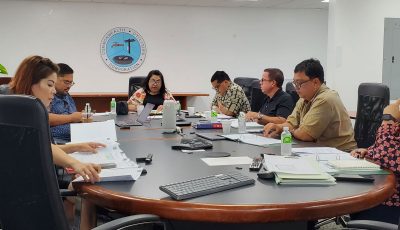Consultant: CUC energy losses at least $5M a year
The consultant for the Commonwealth Public Utilities Commission has recommended for the Commonwealth Utilities Corp. to reinstitute its taskforce dealing with unaccounted for energy and submit a status report regarding the “extraordinarily large” percentage of power losses in the CNMI.
In his presentation at the CPUC hearing last week, Georgetown Consulting Group, Inc.’s Larry Gawlik said that a report and plan must be made to identify losses, remediation efforts, costs of remediation, and schedule for the remediation.
“We recommend that CUC perform a meaningful status report, consider reinstituting the ad-hoc unaccounted for energy taskforce that it put together for the purposes of determining these losses and developing a plan,” Gawlik said.
In addressing this issue, Gawlik said “It represents probably the single largest opportunity for CUC to improve its efficiency with regards to delivery of power. It is a larger opportunity than building new power plants.”
In simple terms, Gawlik described unaccounted for energy as “energy produced at the power plant but for some reason never makes it to the customer’s bills.”
Power produced minus energy sold equals unaccounted for energy.
These losses can be technical or line losses which are caused by wires, physical lines, transformers, or other infrastructure part of the distribution and therefore can be estimated accurately and can be controlled.
Non-technical losses, on the other hand, are those that result from factors such as inaccurate meter, meter reading error, transformation error, incorrect meter multiplier in the billing, theft, and others.
Gawlik noted that since 2012—when CPUC ordered CUC to implement the recommendations in the Pacific Power Association’s 2010 KEMA study for reducing CUC’s unaccounted for energy losses to industry norms—they have received only one status report from the corporation.
No change since 2010
Gawlik stated that CUC is basically the same as it was when KEMA made its analysis six years ago.
He stated that losses on Saipan were pegged at 14.85 percent, 19.29 percent for Tinian, and 19.63 percent for Rota.
Gawlik said that these are “extraordinarily large numbers” particularly when normal technical losses is 8 percent.
This means, Gawlik said, that 7 or 8 percent of the losses are non-technical losses—which, by industry standard, should be less than 1 percent.
“Somebody has to pay for all these losses,” Gawlik said.
“Both losses are paid for by customers,” he added, noting that these losses find their way to customer billings in the way the fuel adjustment charges are calculated and the way rates are calculated.
Gawlik said that these losses—paid for by electric ratepayers—are worth conservatively $3 million to closer to $5 million a year in current fuel costs or may have amounted to $8 million “during the hyper fuel costs two years ago.”
Not acceptable
In their response, CUC management said they don’t need to be tasked in addressing this issue as they have been making efforts to do so.
“We continue to review and make efforts to identify losses,” CUC acting executive director Gary Camacho said.
He acknowledged that the numbers are “very high” and that it is “not acceptable to CUC.” He also said that they “understand the responsibility” of CUC regarding the matter.
During the restoration efforts after Typhoon Soudelor, CUC noted that they have made efforts to review their transformers and “try to size them along the way” as a way of addressing losses. They have replaced 600 to 700 transformers after Soudelor.
CUC said it will be more than happy to comply with Georgetown’s recommendations to put together a team and make a written report by September.
“I think we should be able to have most of it by September if not all but if possible if I need another month, hopefully they consider my request if that is possible,” Camacho said.



























